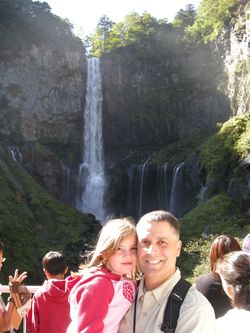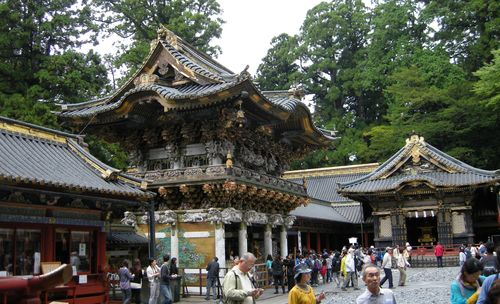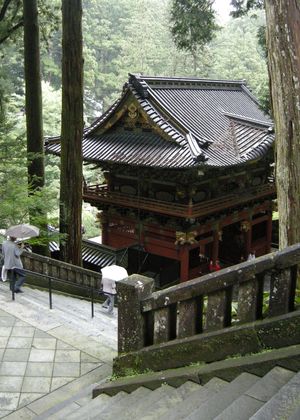CONTRIBUTED BY JOY BARNES
On a recent trip to mainland Japan, I discovered an important insight into how my family travels… we do much better in the small towns. We spent three nights in Tokyo and three nights in a gem of a town called Nikko, about 2 hours by train north of Tokyo. While Tokyo was definitely a “must-see” during our time living in Japan, it was not an easy adventure for our family which includes a five year-old, a two year-old, and a very pregnant mom. While I’m glad we got to experience the vastness of this worldly city, the small-town charm of Nikko proved to be just the right pace for us.
The town of Nikko which lies on the outskirts of the Nikko National Forest, is known for its beautiful Buddhist and Shinto temples which are tucked away on a wooded hillside. In my Japan guidebook, Nikko is listed as a day-trip from Tokyo, but to get the full feel of this city, I would suggest staying at least a night or two.
Our first day in the city, we spent exploring the temples and shrines which are listed as UNESCO World Heritage Sites. The setting is a gorgeous forest with stone walkways lined with giant cedars leading to one beautiful piece of Japanese architecture after another. The buildings date back to the 1600’s, although a couple have been reconstructed after fires destroyed the originals. To fully appreciate the experience, you should purchase the multi-ticket pass which allows entrance into various buildings throughout the temple grounds. The detail in the lacquer working and carvings gives you plenty to admire. One such detail is a famous “see no evil, hear no evil, speak no evil” monkey carving that has become somewhat of an icon for the city.
 The other major site to see in town is the Shin-kyo Sacred Bridge originally built in 1636. The bridge that spans the Daiya River today is actually a reconstruction built in 1907 after floods washed away the original. Situated just prior to getting to the World Heritage Sites, the bridge is a beautiful landmark that seems to connect the more modern city to the old tradition of the temples and shrines.
The other major site to see in town is the Shin-kyo Sacred Bridge originally built in 1636. The bridge that spans the Daiya River today is actually a reconstruction built in 1907 after floods washed away the original. Situated just prior to getting to the World Heritage Sites, the bridge is a beautiful landmark that seems to connect the more modern city to the old tradition of the temples and shrines.
The following day, we took our hotel shuttle out to the Nikko National Park to view the Lake Chuzenji area known for its waterfalls. After a slight detour (aka. missing our planned bus stop), we came across the beautiful cascading waterfalls of Ryuzu Cascade Terraces. It’s set deep in the woods, but has an easily accessible paved path and a quaint café and viewing platform at the base of the falls.
 We also visited the larger and more commercialized Kegon waterfalls. An entrance fee is required to take the elevator to the viewing platform, but it is worth the money as the nearly 100 meter falls is impressive to see. Despite the aforementioned “detour”, the city bus was easy to manage and we took this back to downtown Nikko for about 1000 yen.
We also visited the larger and more commercialized Kegon waterfalls. An entrance fee is required to take the elevator to the viewing platform, but it is worth the money as the nearly 100 meter falls is impressive to see. Despite the aforementioned “detour”, the city bus was easy to manage and we took this back to downtown Nikko for about 1000 yen.
As for accommodations in Nikko, we stayed at the historic Nikko Kanaya hotel. The hotel was established in the 1870’s when the Kanaya family first opened their home to foreign travelers. It has since grown to a beautiful hotel that throughout its history has hosted guests such as Charles Lindberg, Helen Keller and Albert Einstein. The Kanaya Hotel prides itself on its history and this pride carries over to a tradition of great service, charming rooms, and beautiful grounds. There are hiking paths on the grounds of the hotel and my husband and kids even saw a wild monkey right outside one of the hotel windows! A room at the Nikko Kanaya is rather expensive, so if a stay is not in your budget, it’s still possible to experience the old-world charm of this hotel by walking around the hotel grounds and enjoying a cup of tea in the beautiful dinning hall.
Getting to Nikko: There are a few different routes to get to Nikko from Tokyo. We took the most direct route from Tokyo via the Asakusa Train Station on the Tobu line to the Tobu Nikko Train Station. It cost about 3000 yen per person. The website www.hyperdia.com gives you many other options.
Additional Tips for Nikko:
• For additional hotels, there seemed to be a number of small inns in both Nikko itself and in the Lake Chuzenji area. Check hotels.com or japanican.com for listings.
• ATM’s that accepted our American cards were next to impossible to find in Nikko. Luckily we had some US dollars we could exchange at our hotel, but I would suggest bringing more Yen than you think you will need or consider investing in a few traveler’s checks.
• Beware… the temples in Nikko have a lot of stairs so I would not advise bothering with a stroller. Plan to bring the Baby Bjorn if you have really little ones or be ready to carry your toddler a lot.
• None of the trains we took had luggage storage outside of the small overhead racks, so plan to pack lightly.






Excellent write up! Thanks for all the information.
Besides maybe CitiBank, and a rare few others (maybe 7Eleven), there are no Foreign Bank ATM machines in Japan. However, every Japan Post Office has ATM machines that work for American ATM cards…very handy in a pinch. Look for the green and white sign and jump in and grab some cash. Plus you get a better exchange rate than base ATM machines. And yes, the machines are in English.